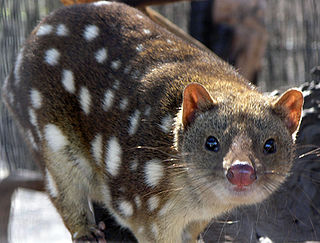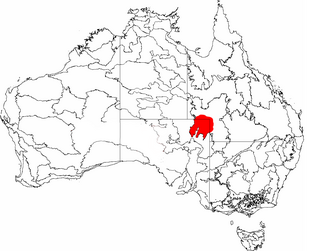
Astrebla Downs is a national park in Shire of Diamantina, Queensland, Australia.

A hopping mouse is any of about ten different Australian native mice in the genus Notomys. They are rodents, not marsupials, and their ancestors are thought to have arrived from Asia about 5 million years ago.

The numbat, also known as the noombat or walpurti, is an insectivorous marsupial. It is diurnal and its diet consists almost exclusively of termites.

The Dasyuridae are a family of marsupials native to Australia and New Guinea, including 71 extant species divided into 17 genera. Many are small and mouse-like or shrew-like, giving some of them the name marsupial mice or marsupial shrews, but the group also includes the cat-sized quolls, as well as the Tasmanian devil and the extinct thylacine. They are found in a wide range of habitats, including grassland, underground, forests, and mountains, and some species are arboreal or semiaquatic. The Dasyuridae are often called the 'marsupial carnivores', as most members of the family are insectivores.

Mulgaras are the six small rat-sized species in the genus Dasycercus. They are marsupial carnivores, closely related to the Tasmanian devil and the quolls, that live in deserts and spinifex grasslands of arid Australia. They are nocturnal, but occasionally "sunbathe" in the entrance of the burrow in which they dwell. Their kidneys are highly developed to excrete extremely concentrated urine to preserve water, as the animals rarely drink. They feed mostly on insects, but also eat reptiles and small mammals. They are seasonal breeders and breed from June to September. The pouch comprises two lateral folds of skin.

The desert rat-kangaroo, also called the buff-nosed rat-kangaroo, plains rat-kangaroo or oolacunta, is an extinct small hopping marsupial endemic to desert regions of Central Australia. It was first recorded in the early 1840s and described by John Gould in London in 1843, on the basis of three specimens sent to him by George Grey, the governor of South Australia at the time.

The lesser bilby, also known as the yallara, the lesser rabbit-eared bandicoot or the white-tailed rabbit-eared bandicoot, was a rabbit-like marsupial. The species was first described by Oldfield Thomas as Peregale leucura in 1887 from a single specimen from a collection of mammals of the British Museum. Reaching the size of a young rabbit, this species lived in the deserts of Central Australia. Since the 1950s–1960s, it has been believed to be extinct.

The kultarr is a small insectivorous nocturnal marsupial inhabiting the arid interior of Australia. Preferred habitat includes stony deserts, shrubland, woodland, grassland and open plains. The kultarr has a range of adaptations to help cope with Australia's harsh arid environment including torpor similar to hibernation that helps conserve energy. The species has declined across its former range since European settlement due to changes in land management practices and introduced predators.

Mitchell's hopping mouse also known as the pankot, is the largest extant member of the genus Notomys, weighing between 40 and 60 g. N. mitchellii is a bipedal rodent with large back legs, similar to a jerboa or kangaroo rat. The species occurs throughout much of semi-arid Southern Australia, and appears to be particularly common on the Eyre Peninsula, South Australia. Typical habitat for N. mitchellii appears to be mallee shrublands on sandy dune systems. The species is currently considered to be unthreatened, but its range has been reduced through habitat disturbance and destruction associated with European settlement in Australia.

The tribe Dasyurini includes several genera of small carnivorous marsupials native to Australia: quolls, kowari, mulgara, kaluta, dibblers, neophascogales, pseudantechinuses, and the Tasmanian devil.

Sturt Stony Desert is an area in the north-east of South Australia, far south western border area of Queensland and the far west of New South Wales.
Charlotte Waters was a tiny settlement in the Northern Territory of Australia located close to the South Australian border, not far from Aputula. It was known for its telegraph station, the Charlotte Waters Telegraph Station, which became a hub for scientists travelling in central Australia in the late 19th and early 20th century. Aboriginal artist Erlikilyika, known to Europeans as Jim Kite, lived there. Only a ruin remains today.

The plains rat(Pseudomys australis), also known as the palyoora, plains mouse and eastern mouse, is a conilurine rodent native to arid and semi-arid Australia. Referred to as the pallyoora or yarlie by Indigenous groups, the plains rat was once widely distributed across central Australia, including north-west New South Wales and south-west Queensland; however, habitat degradation due to grazing, introduced predators and drought have contributed to its decline. Consequently, the plains rat has been listed as 'presumed extinct' in New South Wales and Victoria, 'endangered' in the Northern Territory and Queensland and 'vulnerable' in Western Australia and South Australia. While recent research has indicated the presence of the plains rat in areas such as the Fowlers Gap and Strzelecki Desert regions of New South Wales and within the Diamantina National Park in Queensland, there are only five sub-populations currently recognised nationally, none of which coincide with recent discoveries of the plains rat. As the current population trend of the plains rat has been listed as 'declining' by the International Union for the Conservation of Nature (IUCN), the IUCN conservation status for the species is 'vulnerable'.

The crest-tailed mulgara is a small to medium-sized Australian carnivorous marsupial and a member of the family Dasyuridae which includes quolls, dunnarts, the numbat, Tasmanian devil and extinct thylacine. The crest-tailed mulgara is among a group of native predatory mammals or mesopredators endemic to arid Australia.

The brush-tailed mulgara, previously the mulgara Dasycercus cristicauda, is a medium sized carnivorous Australian marsupial species weighing approximately 100 g (3.5 oz). The brush-tailed mulgara is sexually dimorphic with males being much larger than females. Their body length is 12 to 17 cm, and tail length is 6–10 cm (2.4–3.9 in). They store fat in their tail which at times can be over 16 mm (0.63 in) wide at the base.
Lucasium byrnei, also known commonly as the gibber gecko, Byrne's gecko, and the pink-blotched gecko, is a species of small, nocturnal lizard in the family Diplodactylidae. The species is endemic to Australia.
Patrick Michael Byrne (1856–1932), also known as Paddy or Pado, was an Australian telegraph operator, anthropologist and natural scientist who worked at the remote Charlotte Waters telegraph station in central Australia for 50 years. He was a keen self-taught scientist who collected specimens and corresponded extensively with biologist and anthropologist Walter Baldwin Spencer. He also worked with anthropologist Francis James Gillen at Charlotte Waters, and was a friend of and advocate for the local Arrernte people.
















